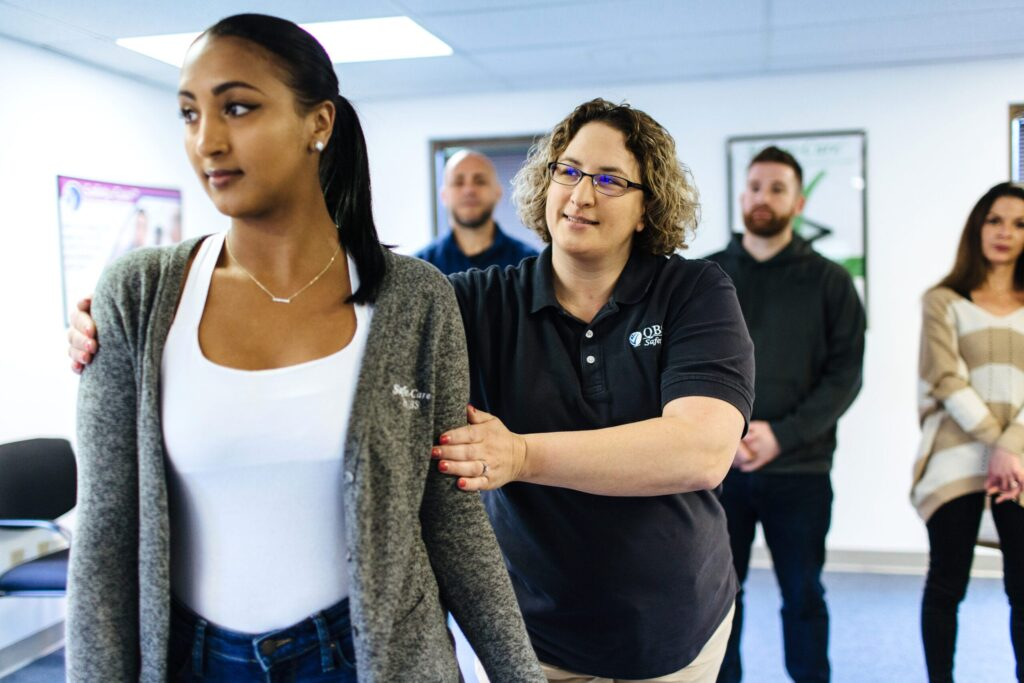Iowa Administrative Rules – Use of Restraint and Seclusion in Schools
In January of 2021, the State of Iowa adopted new administrative rules regarding the use of restraint and seclusion in school settings. Safety-Care can be used as a vital part of staff training to help meet the needs of districts and students in meeting these guidelines. Below is a summary of the administrative rules.

.png?width=88&height=95&name=Group%20137%20(5).png)


How to Implement Safety-Care?
1. Register for a Safety-Care Trainer class or call us to request a closed session for your organization. We regularly conduct classes in all 50 states and Canada.
2. Complete your class to become a certified Safety-Care Trainer for your organization. We bring you to fluency using an errorless teaching methodology.
3. You train and certify your staff in Safety-Care’s effective techniques.
4. Our Master Trainers are available by phone, email, or video to help your organization with any questions or concerns while using or implementing Safety-Care.

Legal Requirements
|
Summary: Effective: January 20, 2021 Last Updated: December, 2024 In January of 2021, the State of Iowa adopted new administrative rules regarding the use of restraint and seclusion in school settings. Safety-Care can be used as a vital part of staff training to help meet the needs of districts and students in meeting these guidelines. Below is a summary of the administrative rules. How Safety-Care aligns: Numerous education organizations throughout the United States and Canada rely upon QBS and our Safety-Care training to provide their staff members with the training they need to help maintain a safe and healthy environment. Safety-Care provides a comprehensive, supportive approach to incident prevention, de-escalation, and management. Your Staff will learn practical strategies for helping students that use evidence-based practices consistent with PBIS (Positive Behavior Interventions and Supports) and ABA (Applied Behavior Analysis). |
|
IA ADC 281-103.3(256B,280) Ban on corporal punishment and prone and mechanical restraints. An employee shall not inflict, or cause to be inflicted, corporal punishment upon a student or use prone restraints or mechanical restraints upon a student. IA ADC 281-103.7(256B,280) Reasonable and necessary force-use of physical restraint or seclusion. 103.7(1) Physical restraint or seclusion is reasonable and necessary only: a. To prevent or terminate an imminent threat of bodily injury to the student or others; or How Safety-Care aligns: This staircase is used to describe how an individual can move up and down from a state of calm to a state of crisis, where violence is possible. As part of the discussion on the staircase, behavioral predictors are reviewed. Safety-Care strategies can then be used to move an individual down the staircase back to a state of calm. Safety-Care certified individuals are trained to use our Help, Prompt, and Wait strategies as early intervention procedures that effectively de-escalate potential crisis situations before any physical management is necessary. Safety-Care is also based on Applied Behavior Analysis practices and regularly updated with the most current research. This ensures that your staff is fully trained in in a system that is focused on de-escalation and is fully trauma-informed. |
|
103.7(2) If seclusion or physical restraint is utilized, the following provisions shall apply: c. The seclusion or physical restraint must only be used for as long as is necessary, based on research and evidence, to allow the student to regain control of the student’s behavior to the point that the threat or behavior necessitating the use of the seclusion or physical restraint has ended, or when a medical condition occurs that puts the student at risk of harm.
|
|
103.8(3) Debriefing. a. Schools must hold a debriefing meeting within five school days of the day the report and letter are mailed or provided to the parent. How Safety-Care aligns: Safety-Care can be a vital part of any developed workplace violence prevention plan. Safety-Care is uniquely designed to provide trainees with the skills to assess potential crises, how de-escalate these situations, and how to respond if the situation is elevated. Our trainings are trauma-informed and focus on modifying behavior to prevent dangerous outcomes. Safety-Care is focused on encouraging positive behavior prior to the use of any other intervention strategy. Our approach stems from the use of Positive Behavior Intervention and Supports (PBIS) that can prevent and manage challenge behavior. Safety-Care requires that all trainees comply with local laws and regulations regarding reporting and debriefing. Additionally, Safety-Care’s Trainer Connect program can be used to assist in documenting interactions where Safety-Care has been utilized. |
Why Safety-Care?
Benefits & Differentiators
In addition to Safety-Care being highly cost-effective, you get:

Skills to effectively prevent, minimize, & manage behavioral challenges with dignity, safety, & the possibility of change

Decreases in staff and patient injuries and reduction in restraint & seclusion time

Instructional procedures based on decades of evidence-based research & compatible with ABA, PBIS & reinforcement-based environments

Customizable program for your setting, staff & clientele, with a strong focus on preventative via non-intrusive, replacement behaviors

Extremely rigorous standards grounded in errorless teaching methodology

Small, intimate class sizes backed by unlimited support & resources
How Is Safety-Care So Effective?
A Genuine Focus on Implementing & Managing Positive Behavioral Skills
Proactive, environmental management recommendations
Understanding of evocative effects of staff behavior
In-depth analysis of antecedents and proactive antecedent interventions
Evidence-based reinforcement procedures
Required competency in de-escalation skills
Humane, non-invasive touch and QBS Check™ strategies
Evidence-based teaching procedures
Applicable to a wide array of settings, conditions & challenging behavior





